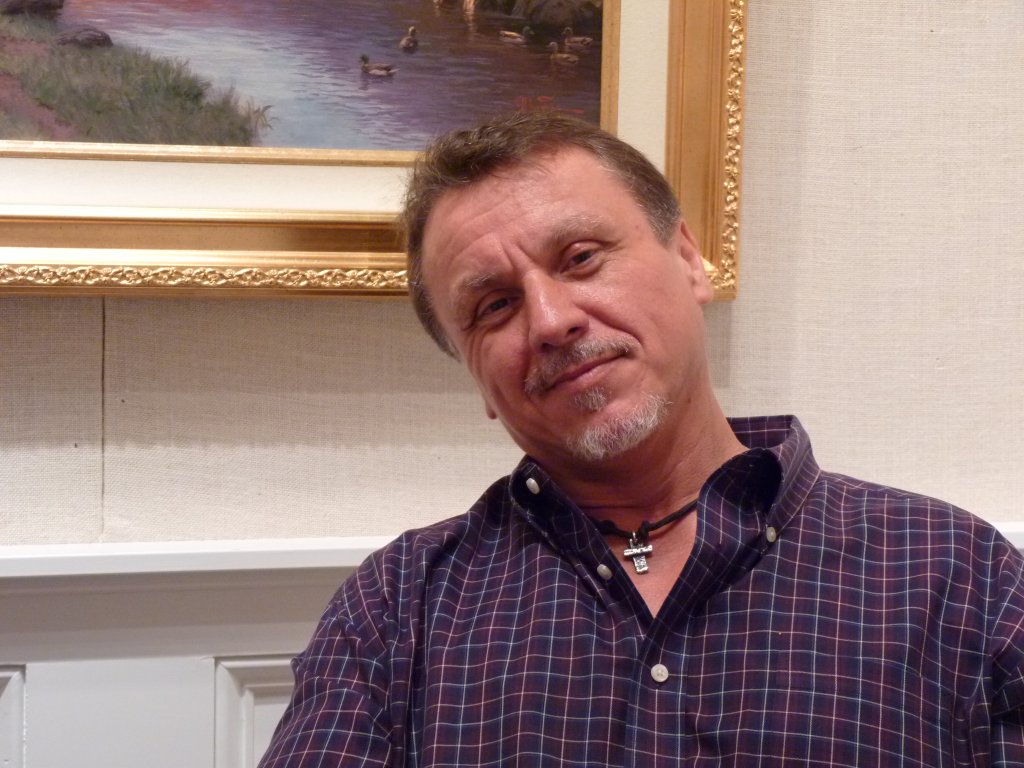CAPE MAY — The death of Thomas Kinkade in April shocked many who owned prints and paintings from the “Painter of Light.”
His paintings of cottages, villages, glowing street scenes and Cape May glowed with a luminescence rarely seen in other works.
His brother Patrick, who is the chairman of the criminal justice department at Texas Christian University, arrived in Cape May Fri. Aug. 17 for the largest exhibit of his brother’s work ever assembled on the east coast at Convention Hall.
While Thomas Kinkade’s death has been fodder for supermarket tabloids, his legacy will continue.
This reporter remembers finding Thomas standing at an easel across the street from Cape May Point Borough Hall one morning a decade ago as he painted the Cape May Lighthouse. He was dressed more as house painter than an artist in stained coveralls.
Patrick Kinkade said Thomas was a left-handed painter who like many southpaw painters drag their hand across their work and wind up with paint on their hands. The coveralls kept his clothing from being ruined, he said.
Painting started early in life for Thomas, said Patrick Kinkade.
“He had this little coffee table and he put a towel over it and he’d line up his crayons, watercolors and his colored pencils and he called it his studio,” said Patrick Kinkade.
“He had a vision of himself as an artist from a very early age,” he continued. “I don’t remember a time in his life when he wasn’t dabbling in the arts.”
Thomas Kinkade studied art history and tried every imaginable style of art, said Patrick Kinkade.
“He painted in surrealism, he painted in impressionism, he painted in expressionism, he painted abstract, he painted in realism, he explored art to its fullest capacity,” he said.
Their sister was a county librarian giving Thomas Kinkade access to art books.
Patrick Kinkade said his brother’s private archives have a wide course of work that would surprise his fans. He painted and sketched every day.
While thousands of Thomas Kinkade’s pieces have been published, “thousands and thousands have been created,” said Patrick Kinkade.
“He painted plein air, he would go out and paint in a sort of frenzied passionate moment and in two or three hours capture the scene in front of him,” he said.
Hundred of those panels are available. In addition there are a number of studio originals that have not been published, some of which were experimental and not intended for public consumption.
Thomas Kinkade was influenced by a school of lumanism in the late 1800s spearheaded by a number of great American landscape artists. Patrick Kinkade said it takes an incredible amount of time to create an original in luminous style.
“You’re talking hundreds of hours in terms of layering on and juxtaposing color in order to get that effect,” he said.
Patrick Kinkade said his mother took him and Thomas to art museums in California which had collections of great American landscapes.
“He was exposed to lumanism as a style early on,” he said.
Their childhood home had inexpensive prints from the five and dime store of masters such as Rembrandt.
“Tom used to say paintings were silent messengers in the home,” said Patrick Kinkade. “If you hang a painting on the wall, it influences you every day whether you know it or not…”
Like many young men, Thomas Kinkade worked regular jobs such as delivering newspapers, working in a pizza restaurant and flagging at motocross races.
“As a kid he got a job at Western Sign Company painting signs at a very early age,” said Patrick Kinkade. “His first major composition that he did alone was Yogi Bear’s Jellystone Park, the largest Kinkade ever painted was an 18-foot Yogi Bear.”
He said he believed the Thomas Kinkade Company will continue much like the Disney Company continued after the death of Walt Disney.
Patrick Kinkade said his brother was not unhappy in his final year of life.
“Like any human, he struggled with his own demons,” he said. “People wanted to make him into some sort of perfect human being and he wasn’t, he was an imperfect vessel.”
He said Thomas Kinkade never let his personal pains touch his art.
“His art I believe was divine,” said Patrick Kinkade. “I think it ultimately speaks for itself.”
He said his brother wanted to touch people in a positive way.
“Despite his personal humanity, he wanted to uplift humankind as a whole,” said Patrick Kinkade.








